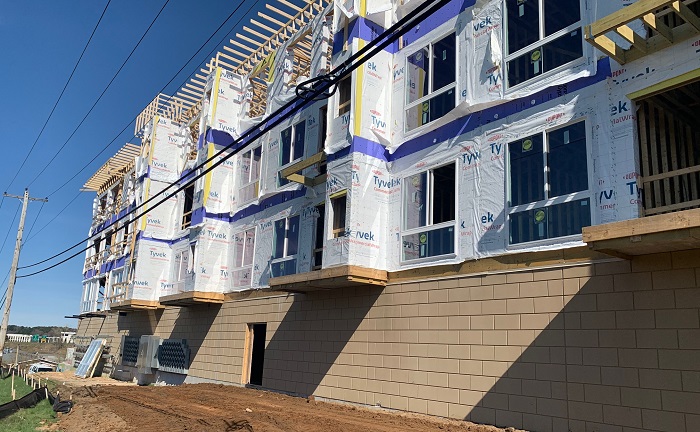Panelization for Apartment Projects

Panelized Construction at Village Park Apartments – Plover WI
Panelization for Apartment Projects
Panelization is expected to grow in popularity as a construction technique in the coming years. Versions of panelization have been around for many years and the advantages are well understood, including cost savings and faster construction progress, even in the winter. Over time, panelization has become even more attractive as a construction technique, due to progress in fabrication, materials, shipping, and improved coordination through computer-aided design.
What is Panelization?
Panelization refers to prefabricated sections of walls, floors, structure, or roofs that are mass-produced on an assembly line in a climate-controlled environment. These prefabricated, modular panels are shipped and installed at the construction site.
This method was first pioneered by the home building industry but has since grown to be widely accepted in the multi-family housing industry. Now it’s commonly used in hotels and apartment complex projects with more than 75 units.

Mountain Lane Apartments in Wausau WI. Working with 12 Gauge Construction (12gcc.com) we used 10′ x 10′ exterior panel wall sections and 7,000 s.f. of interior panel wall sections. Panelized construction allowed the building to be assembled quickly. We were able to get 87,000 s.f. (87 units) under roof in just 6 weeks, during the cold winter months.
Major growth is expected for prefab and modular construction projects. According to a 2020 Dodge Data & Analytics report, “about 90% of users report improved productivity, improved quality, and increased schedule certainty when using these methods compared to traditional stick-built construction. At least 80% of users also reported improved cost predictability, reduced waste, and increased client satisfaction.”
“about 90% of users report improved productivity, improved quality, and increased schedule certainty when using these methods compared to traditional stick-built construction. “
What are the Advantages of Panelization?
- Panels are prefabricated in a climate-controlled environment
- Can be used for floors, walls, structure, and exterior applications
- Can use temperature-sensitive materials and finishes
- Can be built any time of year, regardless of climate (wind, rain, snow, cold, heat)
- Climate control allows for faster construction progress
- Factory machinery/equipment is utilized, allowing for closer tolerances
- Technology can be used to increase output, improve accuracy, and track processes
- Worker safety is enhanced in a factory vs. a construction site
- High level of material/method – controlled manufacturing techniques and inspection
- Identical panels can be quickly and accurately created
- Exterior wall weight is lower (up to 80% lower), reducing the size of the structure
- Finishes and colors are highly stain and fade-resistant
- A variety of surface treatments are available
- Can be especially energy-efficient when insulation is added to wall panels
- Fewer workers are needed to install it
- Panels are resistant to weather and temperature change
- Labor costs can be lower in areas far from the construction site
- Improved schedule predictability
- Efficient use of materials and low level of waste
- Panels are delivered when needed, saving space on the construction site
- High level of precision and consistency
- Allows for the quick erection of panels
- Reduced time workers are exposed to potential site risk
- More economical and lighter weight than site-built panels

Mountain Lane Apartments – Wausau WI
What are the Disadvantages of Panelization?
- Requires a high level of advanced planning and organization
- Close coordination with other materials/trades is essential
- Changes can be difficult to make
- Panel customization drives the cost up and increases the construction time
- Ideally used for projects in which duplication is desirable, such as hotels and apartments
We expect that panelization will grow in popularity as a construction technique in the coming years, especially in apartment and hotel projects. According to Tom Hardiman, Executive Director of Modular Building Institute, “the lack of adequate housing and the shortage of skilled labor, coupled with chronic cost and schedule overruns are leading more people towards this process.” The advantages of lower cost, shorter construction periods, and the ability to build in the winter are compelling. Contact us to learn more.



 Bleck & Bleck Architects
Bleck & Bleck Architects